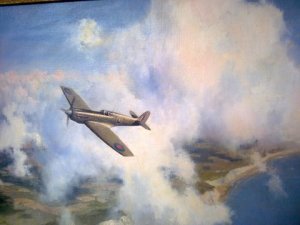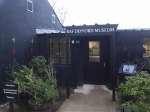
During the Second World War and the Cold War years that followed RAF Defford was one of the most secret places in the country. For it was at Defford that Airborne Radar was developed, tested and proven.
Much of the land required for RAF Defford was requisitioned from the Earl of Coventry in 1940, with the station’s technical area and other airfield buildings being being built on the eastern part of Croome Park and elsewhere on Croome Estate land nearby. The laying of the runways necessitated the closure of a public road, and extended across Defford Common. Various communal and domestic sites, including the Station Sick Quarters (now restored and used to house the RAF Defford Museum and the National Trust reception), were built in Croome Park and around Croome Court, the ancestral home of the Earls of Coventry.

Spitfire EN915, which Group Captain J.McDonald was forced to abandon over Defford in January 1945 – painting by David Shepherd.
Defford airfield was home to the Telecommunications Flying Unit (TFU), a specialist unit tasked with carrying out flight trials for the Telecommunications Research Establishment (TRE). TRE had moved from Worth Matravers on the Dorset coast to the relative safety of Malvern College, Great Malvern in May 1942. The Radar development and trials work carried out at Defford was of immense national importance and operational significance, making a vital contribution to the Allies war effort. Having helped win the war, radar technology also paved the way for many electronic applications that we now take for granted.
The airfield closed for flying in 1957, after it was decided the runways were not long enough or strong enough for large jet bombers just coming into service, and the flying unit made the short move to Pershore airfield, formerly used by the RAF for training. However, Defford then provided a base for radio astronomy, an activity that has continued to the present day.
‘Capability’ Brown re-modelled the landscape of Croome Park in the 18th century, and he was also responsible for much of the rebuilding and decoration of Croome Court. Since 1996, the National Trust has not only restored the landscape park and opened it to the public, but has also preserved and refurbished some of the surviving RAF buildings. Croome Court is open to the public, giving visitors an opportunity to view its long-term restoration.
The Defford Airfield Heritage Group (DAHG) was formed in 2010 as a successor to the RAF Defford Reunion Association. DAHG seeks to research, record, preserve and make better known the history of Defford Airfield in Worcestershire, in formal Partnership with the National Trust, the owners of Croome Park. DAHG was instrumental in the restoration of former RAF buildings which now accommodate the RAF Defford Museum. The Museum, which opened in late September 2014, was created by DAHG with grant funding awarded by the Heritage Lottery Fund. DAHG operate the Museum in partnership with the National Trust. By the end of 2019, the Museum had welcomed over 300,000 visitors.
